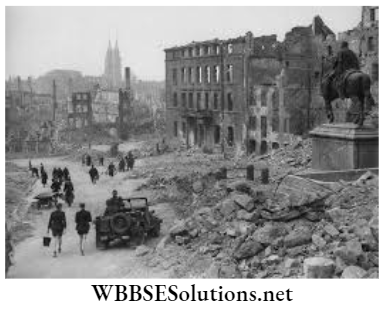Class 9 History Solutions WBBSE Chapter 6 The Second World War And Its Aftermath Topic A The Causes and Course of the Second World War
Explanatory Answer (EA) Type Questions Answer in 12 to 15 sentences
Question 1. What were the causes of the Second World War?
Answer:
The causes of the Second World War which broke out on 13 September 1939 may be discussed as follows:
[1] Unjust terms of the Treaty of Versailles:
The Treaty of Versailles (1919) imposed unjust and humiliating terms on defeated Germany and therefore the Germans continued to nourish their grievances against the Treaty of Versailles.
[2] Hitler’s ambition to become master of Europe:
Hitler became the dictator of Germany in 1934 and began to violate the humiliating terms of the Treaty of Versailles.
[3] Weakness of the League of Nations:
The League of Nations which had been formed to prevent future war became weak and aggressive nations like Germany, Italy and Japan defied the League openly.
Read and Learn More WBBSE Class 9 History Long Answer Questions
[4] Lack of cooperation between England and France:
There was very little cooperation between England and France, the two important powerful member countries of the League of Nations. France wanted to take action against Germany for denying the terms of the Treaty of Versailles, but England did not give full support to this and Hitler took full advantage of this.
[5] Italy’s ambition to become a world power:
Italy, which became one of the most powerful nations of Europe, captured Abyssinia in 1936. Italy’s ambition to become a world power with the help of the Nazi leader of Germany was also a cause of anxiety for England, France and Russia and they apprehended danger from Italy.
Class 9 History Solutions WBBSE
[6] Japanese Imperialism:
After the First World War Japan became a warlike nation and conquered Manchuria and half of China in 1939. The war between China and Japan later merged into the Second World War.
[7] Immediate cause:
The immediate cause of the Second World War is to be found in a series of acts of aggression by Hitler. Germany annexed Austria and then demanded Sudetenland from Czechoslovakia. Soon after Germany swallowed up the remaining portion of Czechoslovakia and demanded Danzig from Poland. Britain, France and Poland formed an alliance to resist German aggression upon Poland.
Meanwhile, Great Britain and France were engaged in negotiations with Russia. But the world was surprised by the news that Germany and Russia had concluded Non-Aggression Pact for 10 years (1939) and this emboldened Hitler to invade Poland without any formal declaration of war. So Great Britain and France declared war against Germany in September 1939 and the World War II began.
Question 2. The fundamental cause of World War II must be sought in the Treaty of Versailles- Discuss.
Answer:
The Fundamental Cause Of World War II Must Be Sought In The Treaty Of Versailles:-
[1] The Treaty of Versailles has been called ‘a dictated treaty’ which was imposed upon vanquished Germany by the victorious Allied Powers. The delegates of Germany were not invited to the Paris Peace Conference (1919) and the treaty was a revengeful treaty.
[2] The treaty did not adhere to the principle of self-determination. The right of self-determination was not applied for Sudetenland which was transferred to Czechoslovakia. It led to a loss of balance of power in Europe.
[3] While England and France increased their colonies, German colonies were confiscated in the name of good government.
[4] The provinces of Alsace and Lorraine were taken away from Germany and were given back to France. The Saar Valley on the western frontier of Germany was handed over to France for fifteen years after which fate of the region was to be settled by a plebiscite. The port of Danzig was also snatched away from the possession of Germany.
[5] Germany was saddled with a huge reparation amount by the Treaty which was impossible for her to pay.
[6] The German bared of staff or general of the army was. dissolved. Germany had to surrender her fleet to the Allies. According to Wilson’s Fourteen Points, it was decided that all the states would reduce their war armaments. But this clause was only applied to Germany.
Humiliated Germany was looking forward to another war as an opportunity to avenge her defeat. So it is said that the fundamental cause of World War II must be sought in the Treaty of Versailles.
Class 9 History Solutions WBBSE
Question 3. How did the failure of the League of Nations constitute a cause of the Second World War?
Answer:
Failure Of The League Of Nations Constitute A Cause Of The Second World War:-
The terrible effects of the First World War (1914-18) had stunning effects on the minds of the people and made them cry for peace. President Wilson of America took the initiative and made a plan for the League of the primary object of which was to prevent Nations which was established in 1920, armed conflict.
Many international problems arose after the First World War. At first, the problems were comparatively easy and the League of Nations was able to solve some of them by peaceful methods. But the League’s inability to control the Great Powers become quite evident in the thirties which constituted a cause of the Second World War.
In 1931 when Japan swallowed Manchuria the League did not adopt any penal measure against Japan, the grievances of China’s failure of the League the autocrats of different remained unredressed. Encouraged by the countries also started aggression totally ignoring the League of Nations.
In 1935 Italy under the dictatorship of Mussolini invaded and occupied Ethiopia (Abyssinia) in Africa. Ethiopia complained to the League and a decision was made by the League Council for enforcing of economic sanctions against Italy. But Italy did not obey League’s order and resigned from the League of Nations.
During Spanish Civil War the League was unable to adopt effective measures to restore peace in Spain and to prevent external intervention. Franco became victorious and this added to German confidence. For this reason, the Spanish Civil War is regarded as the stage rehearsal for the Second World War. The failure of the League made Hitler and Mussolini bolder.
Immediately after the assumption of dictatorial power Hitler withdrew Germany from the Disarmament Conference in 1933 and from the League of Nations. Within a few years, Hitler swallowed Austria and Czechoslovakia (1938-39) and invaded Poland in 1939.
The invasion of Poland by Germany was the signal for the outbreak of the Second World War. In no case could the League of Nations prevent or restrict Hitler’s aggressions. Thus the failure of the League of Nations in different international disputes constitute a cause of the Second World War.
History Class 9 WBBSE
Question 4. Describe the course of the Second World War.
Answer:
Second World War:-
The shameful Treaty of Versailles (1919) was imposed on Germany after the First World War (1914-18) by the Allied powers. Hitler rejected the Treaty of Versailles and invaded Poland in 1939 which led to the outbreak of the Second World War. Germany occupied half of Poland. After conquering Denmark and Norway, Germany turned westward and attacked Holland and Belgium. Germany occupied France in 1940. Then Germany invaded Russia and at the Battle of Stalingrad Germany was defeated.
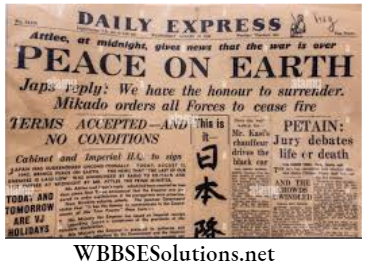
Fascist Italy invaded North Africa after joining World War Newspaper excerpt on the Japanese surrender Il as an ally of Germany. Italy was defeated by Anglo-American forces. Anglo-American forces landed at Normandy in France and attacked Germany. At last Germany was defeated after strong resistance.
History Class 9 WBBSE
Germany was attacked by the Russians in the East Frontier and the Anglo-French-American army in the western frontier and Germany surrendered. The eastern bank of river Elb was occupied by Russia and the western bank of Elb was occupied by Anglo-American forces.
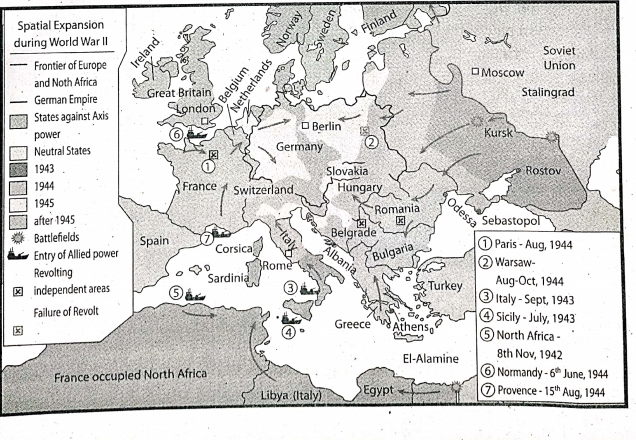
In the far east Japan invaded Manchuria in 1931 and China in 1936. She attacked and destroyed the American naval base at Pearl Harbour in 1941 and joined the Second World War. After the defeat of Germany and Italy, the Allies attacked Japan in full force. After atom bombs were dropped on Hiroshima and Nagasaki, Japan surrendered to the Allies. With the fall of Japan, the Second World War came to an end.
Question 5. Give an account of the struggle between Soviet Russia and Germany.
Answer:
Struggle Between Soviet Russia And Germany:-
The Russo-German Non-Aggression Pact was signed in 1939 for 10 years between Russia and Germany. Hitler violated this pact and attacked Russia in 1941. He did this because he feared that Russia was fast building her defence and increasing her armaments. He suspected that Russia might attack Germany. Without warning, Hitler sent three large armies across Russia’s western frontier. Vast areas of Russia were under Nazi control.
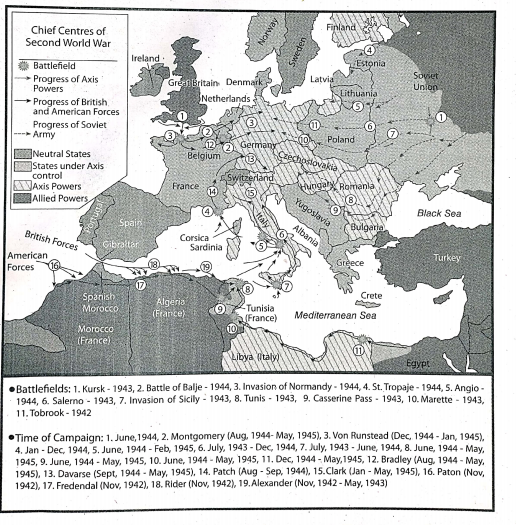
But the Germans were still not complete victors. The Russians adopted guerilla tactics and a ‘scorched earth policy to harass the GermAnswer: The Germans could not capture key cities of Leningrad, Moscow, Stalingrad and Sebastopol. The German soldiers were halted due to the severe winter. Hitler ordered a limited withdrawal in 1942.
History Class 9 WBBSE
Hitler in the meantime was planning a new offensive which was to concentrate on the Caucasus oil field. Despite the resistance of the Russians, the German army occupied the Don. His objective was to capture Caucasus and Stalingrad. Exhausted by immense distance and extreme winter Germany failed to capture Stalingrad. In 1942 Hitler decided to break of the offensive.
Question 6. Write a note on the Japanese attack on Pearl Harbour.
Answer:
Japanese Attack On Pearl Harbour:-
On December 7, 1941, the Japanese launched a surprise attack on the US Naval Base at Pearl Harbour. The Japanese destroyed many US ships and killed many soldiers. It was this attack that forced the US to enter World War II. Pearl Harbour is located in Hawaii on the island of O’ahu. Hawaii is located in the Pacific Ocean between California and Japan. During the time of World War II, Hawaii was not a state, but a US territory.
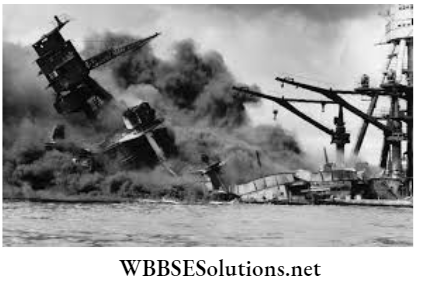
World war II had been raging in Europe and Asia for 2 years but the US had not entered the war. Japan was trying to take over much of Asia and was worried about the US Navy in Hawaii. Japan decided to strike the Pearl Harbour to cripple the US navy and to prevent the US from attacking them.
The attack on Pearl Harbour came as a complete surprise. Hundreds of Japanese fighter planes and bombers flew to Pearl Harbour and attacked the US warships. The bombers dropped bombs and torpedo on the US warships while the fighter planes attacked the US fighter planes on the ground.
A number of US ships were destroyed. The next day, December 8, 1941, the US declared war on Japan. Three days later Japanese allies, Germany and Italy, declared war on the US. The US was now a major part of World War II.
| Attack on Pearl Harbour: Part of the Pacific Theatre of World War II | |
| Date | 7 December 1914 |
| Place | Pearl Harbour, Hawaii Territory, United States |
| Result | Japanese major tactical Victory US declaration of war on Japan Italy and Germany declared war on the United States United States entry into the Second World War |
Question 7. Discuss the role of USA in the Second World War.
Answer:
Role Of USA In The Second World War:-
USA followed a policy of neutrality towards international politics after the First World War. She did not join the Second World War and kept herself aloof from the war. But when Japan attacked the US naval base at Pearl Harbour on 7 December 1941, USA joined the war.
Class 9 History WBBSE
[1] Deviation from the path of neutrality:
During World War II, the USA was sympathetic towards the Allied powers. In 1939 the American legislature allowed USA to help the western democratic states and sell arms and ammunition to them. This policy was known as the ‘Cash and Carry Policy’.
It was a policy to preserve neutrality while aiding the Allies. It allowed sale of arms, ammunition and war. materials to belligerents (countries engaged in war) as long as the recipients arranged for transportation using their own ships and paid immediately in cash, assuming all risk in transportation.
[2] System of conscription:
In the USA a system of conscription was introduced. According to this, all youths in the age group between 21 and 31 were obliged to join the army.
[3] Lend-lease Act:
The American Senate enacted the Lend-Lease Act in March 1941 and allowed the US government to offer warships, warplanes and other weapons to the Allied Powers to fight against fascism. USA become the arsenal of democracy.
[4] Incident of Pearl Harbour:
Japan. attacked the American fleet at Pearl Harbour in the Hawaiian islands on 7 December 1941 with 360 aircraft and wiped out all the American planes on the ground there. This incident forced the USA to join the Second World War.
Question 8. What were the causes of defeat of the Axis Powers in the Second World War?
Answer:
Axis Powers In The Second World War:-
In the Second World War (1939-45) the Axis powers (Germany, Italy and Japan) were defeated by the Allied powers (England, France, Russia, USA and China).
The causes of the defeat of Axis Powers are as follows:
[1] The Axis Powers were not equipped for a major world war and could not withstand the combined attack of three advanced nations like Britain, USA and Soviet Union.
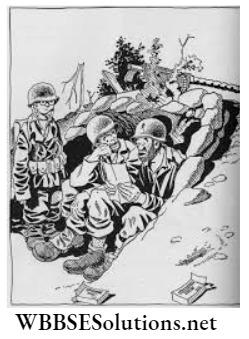
[2] Germany produced all sorts of wonderful gadgets during World War II-except the one that mattered: the atomic bomb. Germany’s nuclear project was disjointed and poorly supported.
[3] Hitler relied on the strength of the German airforce which was outnumbered due to the entry of USA and Soviet Union.
Class 9 History WBBSE
[4] The German attackers believed that Soviet Communism was a corrupt and primitive system that would collapse. But the air and tank armies were reorganised and the technology available was hastily modernised to match the Germans.
[5] Spain was a member of the Axis Powers during the war, but it never committed troops to the effort. Led by Fascist dictator Francisco Franco, the country steadfastly refused to enter into the thrall.
[6] The Allied Powers who wanted to establish democracy had world sympathy behind them which the Axis Powers failed to get.
[7] The people of the territories conquered by the German armies were harshly treated and the Nazis faced opposition from the conquered territories.
[8] Intrigue among the German Generals also contributed to the defeat of Germany.
[9] When USA joined the war, the power of the Allies exceeded all that Germany, Japan and her allies could summon together and led to the defeat of Germany.
[10] Hitler’s high ambition and dominating nature was also responsible for his failure. He was suspicious and even distrusted his lieutenants like Goering and Himmler which brought about his downfall.
Class 9 History Question Answers WBBSE Chapter 6 The Second World War And Its Aftermath Topic B Impact of the Second World War and Ultranationalism vs. Internationalism
Explanatory Answer (EA) Type Questions Answer in 12 to 15 sentences
Question 1. What was the impact of the Second World War on contemporary history?
Answer: The Second World War (1939-45) was a momentous event which changed the whole world.
The impact of the war on contemporary history were as follows:
[1] After the Second World War two great powers called ‘Superpowers’ emerged- the United States of America and the Union of the Soviet Socialist Republic.
[2] The powers like Britain and France which were important before the war were pushed to the background.
[3] In the struggle between the two ideologies-democracy and communism, the latter emerged with more strength.
[4] During 1946-47 the government of Poland, Czechoslovakia, Yugoslavia, Albania, Bulgaria, Hungary, and Romania were converted into communist dictatorships.
Class 9 History WBBSE
[5] Democracy remained in western Europe.
[6] The post-war world saw a growing tension among the Allies- between East and West, and more specifically between Russia and the United States. The result was the Cold War.
[7] To counteract communism the western responses were the Truman Doctrine, Marshall Plan and the North Atlantic Treaty Organisations. The Warsaw Pact was the Soviet response.
[8] After the Second nations emerged which refused to join either of World War, a third force i.e., the Non-aligned the two power blocks.
[9] The Second World War quickened the national feeling among the people of the colonies all over the world. Many of the colonised countries of which India was one, won their independence through anti-imperialist movement. Between 1945 and 1960 no less than 40 countries revolted against colonialism and won their independence.
[10] International organisations like the U.N.O was established in 1945 for the maintenance of peace and security throughout the world.
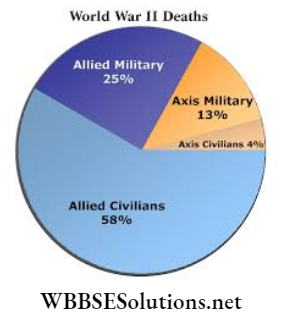
Question 2. Write a note on the qualitative and quantitative changes brought about by the destructiveness of the Second World War.
Answer: The Second World War which broke out in 1939 continued for a long period of six years and came to an end in 1945. The war is known as the most destructive of all wars fought ever before. There was worldwide destruction of life and wealth. The vast destruction of material wealth and loss of human life during the course of war could not be exactly estimated.
[1] In the war at least 57 million people lost Leningrad and Stalingrad were completely their lives. About 7.5 million Russians, 3.5 million Germans, 2.2 million Chinese, and 1.2 million Japanese lost their lives. Many people died in Korea, Italy, Canada, Greece, Belgium, Romania, Bulgaria, and Hungary. The USA dropped atom bombs on Hiroshima and Nagasaki. About 70 thousand people in Hiroshima and 40 thousand people in Nagasaki died. At least 6 million Jews were killed by the Nazi government.
[2] It is estimated that near about one lac crore rupees must have been spent over the war by the nations which participated in it. Great Britain alone had to suffer the economic loss of about 2000 crore rupees. The national property of various countries of the world was destroyed in the war. The European economy collapsed with 70% of the industrial infrastructure destroyed.
[3] Destruction of the property was the highest in Russia. Due to the German attack vast areas of Russia including destroyed. Not only was there loss of lives, many cities and industrial areas of Russia were totally destroyed. But Japan suffered the most. In Hiroshima and Nagasaki, houses and causes were completely destroyed. At least 30% people of 60 big cities became homeless in Japan. In Britain and France, thousands of houses and roads were completely destroyed.
